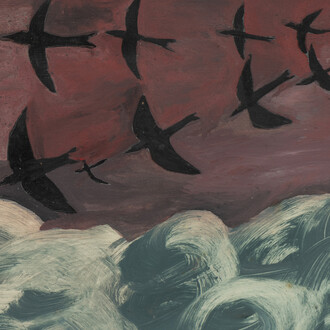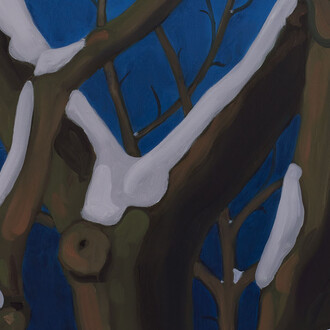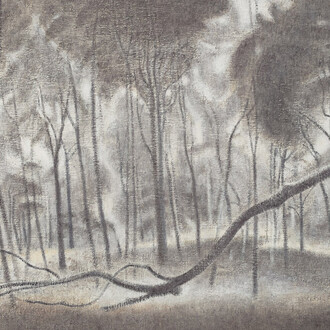This fall, the New-York Historical Society presents a special exhibition that explores the rich, complex, and varied relationships between New Yorkers and their animal companions across the last three centuries. Pets and the city, on view October 25, 2024, through April 27, 2025, surveys how the conception of pets has evolved in tandem with the development of New York—from the role of animals among Indigenous cultures, such as the Lenape and Haudenosaunee, and the hunting culture that accompanied settlers from Europe, to the pampered pets that are considered members of the family today. Through a broad spectrum of works of art, objects, photographs, documents, and memorabilia drawn largely from New-York Historical’s Museum and Library collections, as well as film and television clips, the immersive exhibition also examines the broader social context for New York’s pet population and related topics, including pet adoption, the trafficking of exotic animals, animal rights laws, and the role of service animals. Pets and the City is curated by Roberta J.M. Olson, curator of drawings emerita.
“New York City residents have always loved their pets, and this exhibition reveals the important role that pets have played throughout the city’s history beyond providing companionship to their owners”, said Louise Mirrer, president and CEO, New-York Historical. “I hope visitors come away from this exhibition with a deeper appreciation for the profound impact pets have had on our city’s culture and society and a more nuanced understanding of the complexities of our animals”.
“In New York City alone, it is estimated there are more than two million animal companions who reign over human hearts, homes, and pocket books”, said Roberta J.M. Olson, curator of drawings emerita. “Given that, it’s fascinating to explore how these creatures rose to such a place of distinction. From the origins of pets among Indigenous people to today’s doggy daycares and cat cafés, this exhibition offers a visual journey through the evolving relationship between Gotham’s people and its animals as the city and its population transformed into a diverse metropolis. City dwellers’ relationships with animals and pets illuminate humanity’s relationship with nature and are the bellwether of our shared future and the fate of our planet”.
Pets and the City begins with an exploration of the essential role that animals played in early American societies, both among Indigenous peoples and settlers. For many Native people, animals are considered kindred spirits and integral parts of a spiritual and moral unity, where the natural world is a sacred web of relationships; hunting was not merely a means of sustenance but a ritualized act that honored the deep connection between humans and animals. Exhibited documents from 1788 reveal Mohawk individuals signing their names with drawings of their clan animals, such as turtles and foxes, reflecting their reverence for animals as clan symbols passed down through women in matrilineal societies.
Depictions of hunting dogs in songbooks and “paper dolls” testify to the central position hunting also played for settlers in 18th-century culture. In the late-18th and early-19th century, pets began to be considered members of the nuclear family as an increasingly urbanized environment fostered a greater reliance on domesticated animals to preserve a sense of attachment to the natural world between humans and animals. Family portraits from this time period not only feature the family pet, but often make them the focal point. On view are a variety of family portrayals showing how pets became fixtures in domestic scenes, including Charles Willson Peale’s portrait of the Peale family, to which he added his beloved dog Argus at a later date. Other portraits feature pets from around the world—exotic birds, tropical fish, reptiles, and primates—common in the bustling port city. Videos showcase “A Peek at Presidential Pets” and an aquarium of a reefer, a hobbyist who keeps corals.
The exhibition also explores the different roles pets have played in everything from commerce to competition. In the late-19th century to early-20th century, commercial trade cards aimed at women advertised a business on one side, and on the other featured beguiling images of cats, birds, and their human counterparts. Children’s games and manufactured toys soon focused on pets, reflecting their status as surrogate companions in an industrialized society; an assortment of these popular games are on display. At the same time, the city saw the advent of many of the first pet shows; the Westminster Kennel club dog show (1877) holds the record for second-oldest continuously-held sporting event. Never to be overlooked, felines were celebrated at the first national cat shows, one in 1881, recorded in a rare postcard in New-York Historical’s collection, and the more widely known one held at Madison Square Garden in 1895, where the winner of Best Long-haired Cat was Cosey the Maine coon.
The history of working animals is also explored with historic photos and contemporary gear for Seeing eye dogs and identification badges for bomb-sniffing dogs. Horses, a main mode of transportation in earlier centuries, are also featured in paintings, photographs, and drawings. At the end of the 19th century, there were almost 200,000 horses in Manhattan and Brooklyn alone, most as the power for public transportation but also as pets used by scores of riding clubs, polo teams, fox hunters, and even cowboys.
Pets and the City also highlights the role of not only pets but pests, and the evolution of animal rights in New York City, including the pioneering 1866 anti-cruelty law and the founding of the ASPCA and Bide-A-Wee, as well as contemporary rescue organizations and events like Broadway Barks. Now, pets are regularly fêted at restaurants like the “Barking Dog,” or the “Black Lab Café,” while the Meow Parlour combines hospitality and pet adoption in one stop.
Programming
A family guide to the exhibition will be available for children, and throughout the exhibition’s run, a variety of family programs will take place, including Little New-Yorkers and Sunday Storytime books and craft activities. A special Halloween event is scheduled to take place in October, welcoming families with a “cuddly, creepy, and crawly” theme. Visit the family calendar for additional details. Private group tours can also be arranged throughout the exhibition.
Support
Exhibitions at New-York Historical are made possible by Dr. Agnes Hsu-Tang and Oscar Tang, the Saunders Trust for American History, the Evelyn & Seymour Neuman Fund, the New York City Department of Cultural Affairs in partnership with the City Council, and the New York State Council on the Arts with the support of the Office of the Governor and the New York State Legislature. WNET is the media sponsor.
















